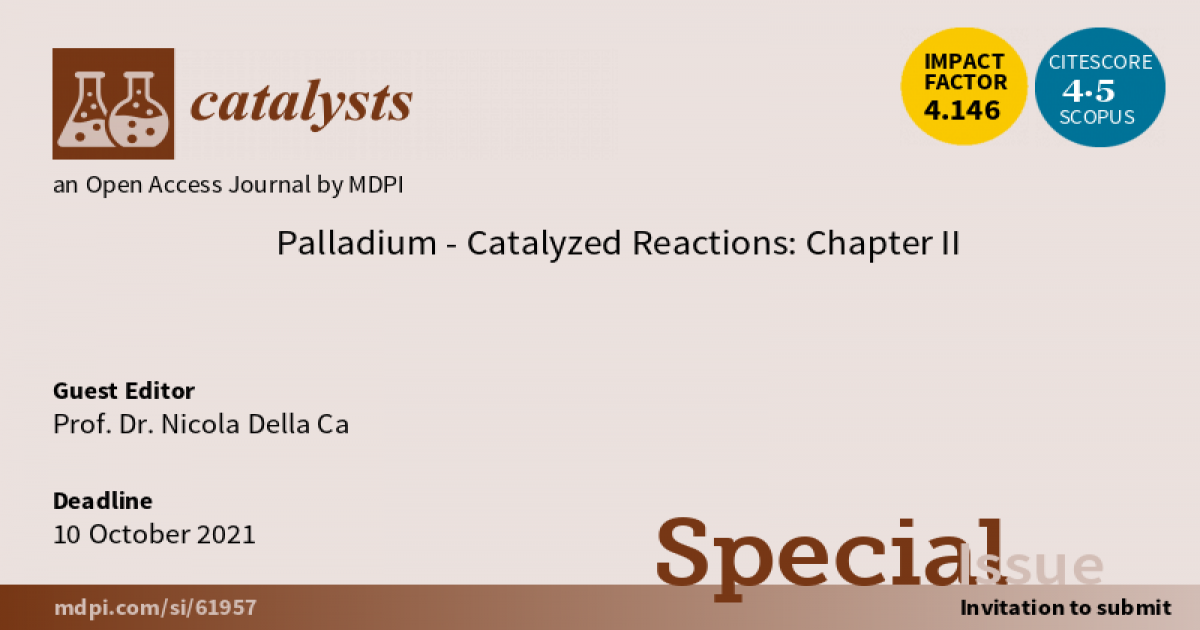Palladium-Catalyzed Reactions: Chapter II
A special issue of Catalysts (ISSN 2073-4344). This special issue belongs to the section "Catalysis in Organic and Polymer Chemistry".
Deadline for manuscript submissions: closed (10 October 2021) | Viewed by 8296

Special Issue Editor
Interests: catalytic sequential reactions for the synthesis of high value-added compounds from readily available reagents; transition metal-catalyzed C-H activation methodologies; carbonylation reactions; CO2 activation chemistry
Special Issues, Collections and Topics in MDPI journals
Special Issue Information
Dear Colleagues,
Palladium is probably the most versatile and exploited transition metal in catalysis due to its capability to boost a wide variety of organic reactions (alkylation, arylation, cyclization, hydrogenation, oxidation, isomerization, cross-coupling, cascade, radical reactions, etc.) both on laboratory and industrial scales. Both homogeneous and heterogeneous palladium-catalyzed reactions continue to play an essential role in organic synthesis. Natural alkaloids, bioactive compounds, pharmaceutical agents, agrochemicals, specialty polymers, etc. can be efficiently accessed through the action of palladium catalysts. Particular attention is devoted to the use of palladium catalysts in C-H bond activation, carbonylation and asymmetric reactions often in combination with other metals. High chemo-, regio-, and diastereoselectivities as well as high levels of molecular sophistication can be achieved employing tailored palladium-based catalytic systems under mild reaction conditions.
Original research papers and topical reviews on recent advancements in the field of palladium chemistry are welcome in this Special Issue of Catalysts.
Prof. Dr. Nicola Della Ca
Guest Editor
Manuscript Submission Information
Manuscripts should be submitted online at www.mdpi.com by registering and logging in to this website. Once you are registered, click here to go to the submission form. Manuscripts can be submitted until the deadline. All submissions that pass pre-check are peer-reviewed. Accepted papers will be published continuously in the journal (as soon as accepted) and will be listed together on the special issue website. Research articles, review articles as well as short communications are invited. For planned papers, a title and short abstract (about 100 words) can be sent to the Editorial Office for announcement on this website.
Submitted manuscripts should not have been published previously, nor be under consideration for publication elsewhere (except conference proceedings papers). All manuscripts are thoroughly refereed through a single-blind peer-review process. A guide for authors and other relevant information for submission of manuscripts is available on the Instructions for Authors page. Catalysts is an international peer-reviewed open access monthly journal published by MDPI.
Please visit the Instructions for Authors page before submitting a manuscript. The Article Processing Charge (APC) for publication in this open access journal is 2700 CHF (Swiss Francs). Submitted papers should be well formatted and use good English. Authors may use MDPI's English editing service prior to publication or during author revisions.
Keywords
- Pd-catalyzed homogeneous and heterogeneous reactions
- Pd-catalyzed cascade reactions
- Pd-catalyzed cross-coupling reactions
- Pd-catalyzed carbonylation reactions
- Pd-catalyzed asymmetric reactions
Related Special Issue
- Palladium-Catalyzed Reactions in Catalysts (14 articles)





